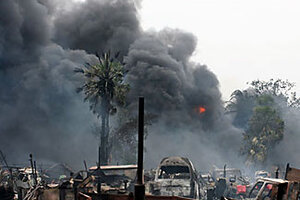Sri Lanka: Can Tamil Tigers go on without their leader?
The military said it shot dead Vellipulai Prabhakaran Monday, a day after the rebels admitted defeat in their 26-year war.

This photograph released by the Sri Lankan military shows what the army says is the battle scene near where Tamil Tigers leader Velupillai Prabhakaran was located. The military said it shot dead Mr. Prabhakaran Monday, a day after the rebels admitted defeat in their 26-year war.
Sri Lankan Government/Reuters
Pune, India
Velupillai Prabhakaran, the founder and chief of the Liberation Tigers of Tamil Eelam (LTTE) was reportedly shot dead Monday by the Sri Lankan army, possibly bringing a final blow to the rebel group just one day after conceding defeat in one of Asia's longest-running wars.
For decades the charismatic leader played an instrumental role in demanding a separate homeland for the island's ethnic Tamil minority and in building up the LTTE's military capabilities.
"[Prabhakaran] was the LTTE's supreme leader, its god, its icon. Minus him, the LTTE will never be its old self," says Narayan Swamy, the New Delhi-based author of a biography of the rebel leader, "Inside an Elusive Mind."
Prabhakaran is believed to have been killed while escaping the war zone in the northeast of the island in an ambulance. His body has yet to be identified. Two of his deputies – LTTE's intelligence wing leader Pottu Amman and Sea Tiger wing leader Soosai – and his eldest son, Charles Anthony, were also killed, according to the military. The claims cannot be independently verified.
A uniquely fierce fighting force
Prabhakaran founded the LTTE in the 1970s in response to discrimination against Tamils by the island's majority Sinhalese population.
For nearly three decades, his group waged war with the Sri Lankan army to achieve a separate homeland for Tamils – or Tamil Eelam – in the north and east of the island. To achieve this goal, he developed a well-trained militia cadre, naval wing, and an air force comprising of rudimentary light aircrafts, becoming the only armed separatist group in the world to have all three military wings.
The LTTE, which is considered a terrorist group by 32 countries, has committed hundreds of suicide bombings.
It has also carried out assassinations of high-profile politicians that got in its way, including former President Ranasinghe Premadasa in 1993 and former Indian prime minister Rajiv Gandhi 1991. The LTTE targeted Mr. Gandhi for his sending Indian troops for peace efforts in 1987 that eventually engaged in open conflict with the rebels.
Supporters of Prabhakaran have praised his dedication to the cause. During peace talks in the 1990s and in 2002 he refused to negotiate for anything less than a homeland.
But Prabakharan has been accused by the government of using the lull period of peace talks to augment his military capabilities – a claim also made by his former lieutenant, Vinayagamoorthi Muralitharan, known as Col. Karuna Amman, who later defected to the government side.
Squeezed into a sliver of land
But after the peace process broke down in 2006, President Mahinda Rajapakse made annihilating Tamil Tiger rebels its priority. He hiked the island's military budget to $1.7 billion for the 2009 fiscal year, nearly 5 percent of the gross domestic product. He also intensified recruitment of soldiers across the island and re-recruited war deserters by granting them amnesty if they returned to the frontlines.
Mr. Rajapakse claimed his actions were necessary given his enemy was one of the world's fiercest armed separatist group.
In recent months, the LTTE suffered severe reverses in the battlefield as the military hemmed rebels into an ever shrinking sliver of land on the eastern coast. On Sunday LTTE official Selvarasa Pathmanathan admitted in a statement that "the battle has reached its bitter end" and that group had "decided to silence our guns."
The military has trumpeted its success in the 26-year war. "Sri Lankan armed forces have militarily defeated the LTTE and freed the nation from three decades of terror," Lt. Gen. Sarath Fonseka, the head of the Sri Lankan Army said in a statement issued on the island nation's defense website.
Next steps
The main challenge now, analysts say, is to work out a negotiated settlement for Sri Lanka's Tamil community, who make up 18 percent of the population, and on whose behalf the Tamil Tigers claim to be fighting.
"The military phase of the war will end soon, and Sri Lanka will witness a post-conflict phase," says Paikiasothy Saravanamuttu, executive director of the Colombo-based Centre for Policy Alternatives. "Now work must begin to give Tamils must be given democratic space."
The Sri Lankan government has yet to announce a blueprint for such a negotiated settlement with Tamils.
"Only after the dust of the LTTE's military defeat settles will the Sri Lankan Tamil community get an opportunity to assess where it is, the nature and extent of the political space available, and what shape its politics could take," says Jayadeva Uyangoda, the head of the political science department at Colombo University.
Meanwhile, Sri Lanka's humanitarian crisis continues to raise international concern. More than 250,000 people people have fled from the war zone since January – 25,000 of these since mid-May alone. Mr. Saravanamuttu says concerns remain whether the country is equipped to handle the pouring out of such an overwhelming number of displaced people.
On Monday, the European Union called for an independent investigation into the alleged war crimes committed by both sides in recent months of fighting.
Questions also remain over whether remaining rebels could wage a low-level insurgency in Sri Lanka.
Even if so, it may not be a realistic threat if the LTTE's top-rung leadership has been wiped out in the current phase of fighting, says Saravanamuttu. "LTTE without its leadership can't do very much."
